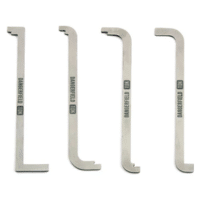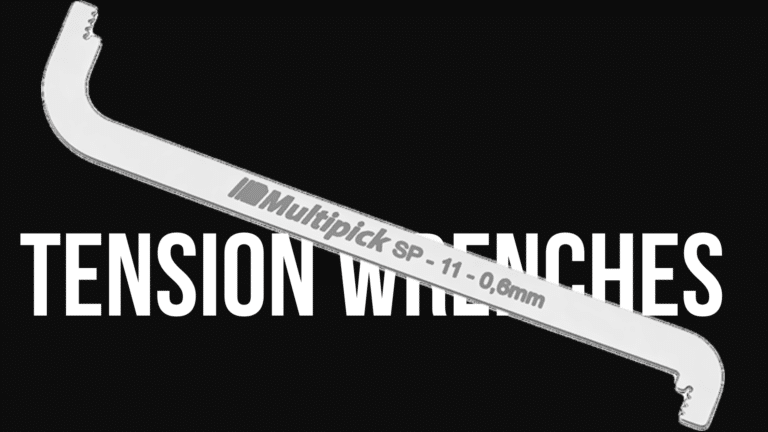WHAT IS TENSION WRENCH AND ITS USED
A tension wrench, also known as a torque wrench, is a tool used in lock picking to apply rotational force to the lock cylinder. This force, known as tension, is crucial for manipulating the lock pins and opening the lock.
Understanding Tension Wrenches
Tension wrenches are the unsung heroes of the locksmith’s toolkit, playing a pivotal role in the art of lock picking. At their core, tension wrenches apply torque to the lock cylinder, allowing locksmiths to manipulate the pins and ultimately open the lock. Understanding the anatomy of a tension wrench is essential. From the shaft to the handle, each component serves a purpose in providing control and feedback during the picking process. Developing a sensitive touch and mastering tension control are fundamental skills that every locksmith must hone to achieve success.
Exploring the World of Tension Wrenches
The world of tension wrenches is vast and diverse, offering a range of options to suit different preferences and techniques. Twisted, bottom of keyway (BOK), and top of keyway (TOK) wrenches are among the most common types used by locksmiths. Twisted wrenches provide versatility and flexibility, while BOK and TOK wrenches offer precision and stability. Understanding the characteristics and applications of each type is essential for choosing the right wrench for the job.
Choosing the Right Tension Wrench
Selecting the ideal tension wrench is a critical step in the lock-picking process. Factors such as material quality, handle design, and compatibility with lock types must be considered. Experimenting with different tension wrench styles is key to finding the perfect fit for your technique and preferences. Remember, the right wrench can make all the difference between a successful pick and a frustrating ordeal.
Mastering Tensioning Skills
Now that we’ve covered the basics, it’s time to dive into tensioning techniques. Constant tension, feather touch, and progressive tensioning are among the most commonly used methods by locksmiths. Each technique requires precision and finesse, but with practice, you can master the art of tension control. Our step-by-step tutorials and practical tips will help you refine your skills and achieve consistent results in your lock-picking endeavors.
The Future of Tension Wrenches
The locksmithing industry is constantly evolving, driven by innovation and technological advancements. From ergonomic designs to cutting-edge materials, tension wrenches are undergoing a revolution. Stay tuned as we explore the latest trends and developments shaping the future of tension wrench technology. Interviews with industry experts and tool manufacturers will provide valuable insights into emerging trends and the driving forces behind innovation in the locksmithing industry.
Keeping Your Wrenches in Prime Condition
Even the best tools require maintenance to ensure optimal performance and longevity. In this post, we’ll share expert tips on troubleshooting common issues with tension wrenches, such as slipping or binding. Proper cleaning, storage, and maintenance practices are essential for keeping your wrenches in prime condition. Our practical advice will help you extend the lifespan of your tools and maximize their effectiveness in the field.
Real-Life Applications of Tension Wrenches
To wrap up our series, we’ll showcase real-life success stories and case studies where tension wrenches played a pivotal role in locksmithing endeavors. From challenging scenarios to innovative solutions, we’ll explore the diverse applications of tension wrenches in the field. Reader submissions and testimonials will be encouraged, allowing the community to share their own experiences and insights.
FREQUENTLY ASKED QUESTION
What is a tension wrench, and why is it important in lock picking?
A tension wrench, also known as a torque wrench, is a tool used in lock picking to apply rotational force to the lock cylinder. This force, known as tension, is crucial for manipulating the lock pins and opening the lock.
What are the different types of tension wrenches?
Tension wrenches come in various types, including twisted, bottom of keyway (BOK), and top of keyway (TOK) wrenches. Twisted wrenches offer versatility, while BOK and TOK wrenches provide precision and stability.
How do I choose the right tension wrench for my needs?
When selecting a tension wrench, consider factors such as material quality, handle design, and compatibility with lock types. Experimenting with different styles will help you find the perfect fit for your technique and preferences.
What are some common tensioning techniques used by locksmiths?
Locksmiths use a variety of tensioning techniques, including constant tension, feather touch, and progressive tensioning. Each technique requires precision and finesse and can be mastered with practice.
How do I troubleshoot common issues with tension wrenches, such as slipping or binding?
If your tension wrench is slipping or binding, try adjusting the amount of tension applied or using a different wrench type. Additionally, ensure that the wrench is clean and free of debris, as this can affect its performance.
How can I maintain my tension wrenches to ensure optimal performance?
To maintain your tension wrenches, regularly clean them with a soft brush and lubricate them with a light oil. Store them in a dry, secure location to prevent damage and extend their lifespan
Can I use tension wrenches for other purposes besides lock picking?
While tension wrenches are primarily used for lock picking, they can also be useful in other applications that require the application of rotational force, such as small mechanical repairs or hobbyist projects.
Are tension wrenches legal to own and use?
In most jurisdictions, tension wrenches are legal to own and use for legitimate purposes, such as locksmithing or hobbyist lock picking. However, it’s essential to familiarize yourself with local laws and regulations regarding lock picking tools to ensure compliance.


